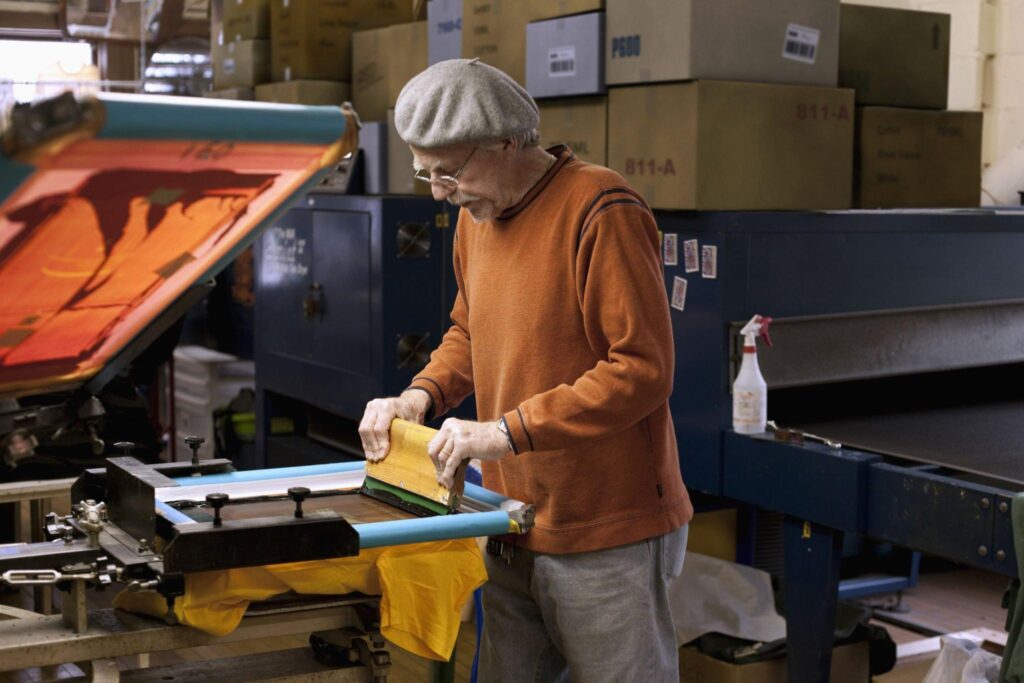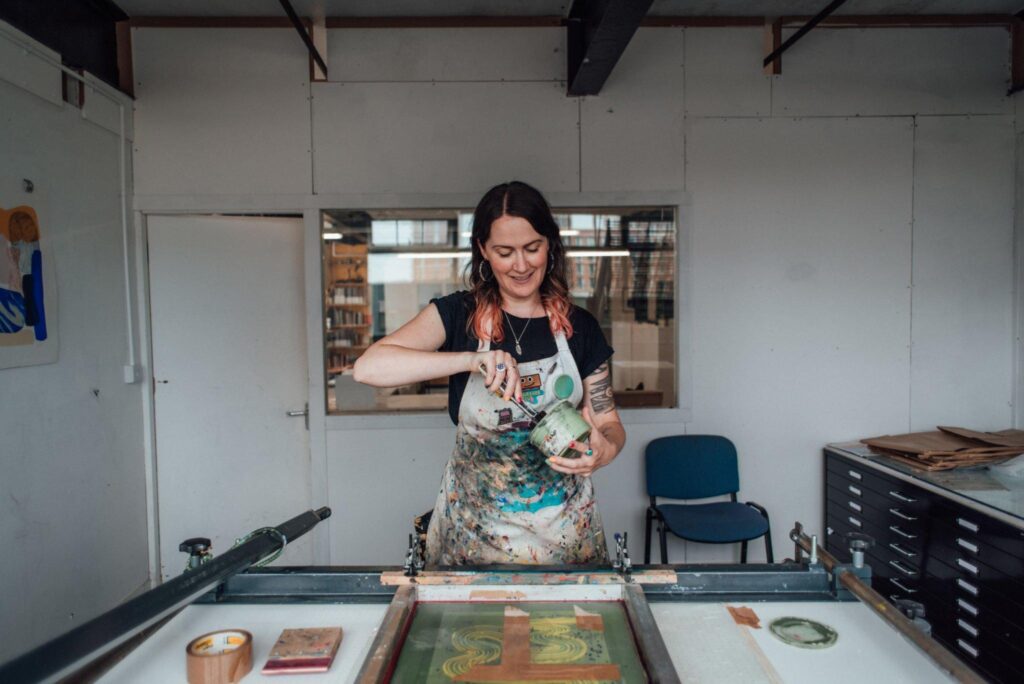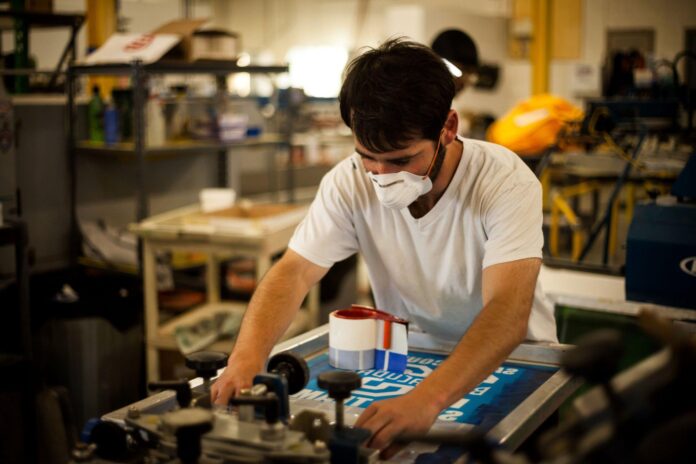How Do You Explain Screen Printing?
Traditional print methods like screen printing have been around for a while. A stencil often referred to as a screen, is used in the screen printing process along with several coats of ink. One layer of ink is added to the printing surface at a time. A distinct screen is employed for every new color or layer. Because of how adaptable screen printing is, it may be used to print on a wide range of materials, including textiles, plastic, and latex.
Mostly clothing manufacturers print the ink directly onto the T-Shirts or other items when screen printing silk. The Silkscreen process creates incredibly long-lasting and robust graphics. Silkscreen-printed clothes can persist for many years since they can survive thousands of washings.
What is Screen Printing?


What is Screen Printing? The old craft of stenciling gave way to screen printing meaning in the late 1800s, and with adaptations and advancements over time, the technique developed into a thriving industry.
Now, it is a very complicated screen print technique that makes use of cutting-edge materials, inks, and computer technology. Screen printing is frequently used in place of other techniques like offset litho. Almost any surface can be printed on with this printing technique, including paper, card, wood, glass, plastic, leather, and fabrics.
Process of Screen Printing
Silk testing or silk screen printing is the procedure. While the actual printing procedure is consistently fairly the same, the manner the stencil is made can differ depending on the materials used. Various stenciling screen printing methods include:
- A woven mesh screen or polyester fabric is used in the process of the screen printing process to support an ink-blocking stencil and produce the desired picture.
- The screen stencil creates open sections of mesh that, when pressed through as a sharp-edged picture onto a substrate, transfer ink or other printable materials.
- During each squeegee stroke, ink is forced through the mesh apertures of the screen stencil, moistening the substrate. The ink is left behind as the screen deflects away from the substrate. In essence, it involves applying ink to a substrate, such as t-shirts, posters, stickers, vinyl, wood, or other materials, using a mesh-based stencil.
- Multiple screens can be utilized to make a multicolored image or pattern since one color is printed at a time.
Is screen printing easy? With just a few step-by-step screen printing processes, you can screen print at home with relative ease. Screen printing is a unique type of art that may be created using only a few simple ingredients or a variety of expensive expert tools. Everything is contingent upon how much time and money you want to invest.


Steps By Step Guide to Screen Printing
Screen printing can be done in several different ways, but they all use the same fundamental strategy. Here, we walk you through each step of the screen printing procedure.
- The printer prints the design they want to appear on the final product exactly onto an acetate film. The stencil will be made using this.
- The complexity of your design and the texture of the cloth should be taken into account when selecting a mesh screen for the screen. After that, a coating of light-reactive emulsion is applied to the mesh screen, which will harden when developed under bright light.
- Acetate Sheet on Emulsion-Coated Screen – The acetate sheet is placed on the emulsion-coated screen, and the entire assembly is exposed to intense light. The sections of the screen that are covered by the pattern remain in liquid form because the light hardens the emulsion. The printer must carefully design each stencil and align them to produce multicolored products with a seamless final design.
- Create the stencil – The sections of the screen that were not covered by the design became hard after being exposed to light. The remaining emulsion is then carefully scraped off. As a result, your design is imprinted on the screen for the ink to pass through. After drying, the screen is prepared for usage.
- The screen is mounted on a printing press to prepare it for printing. The object or garment that will be printed is placed flat on the printing board and positioned beneath the screen.
- The screen is placed onto the printing board to press ink through it. A squeegee is used to move the ink along the entire length of the screen after adding it to the top end of the screen. As a result, the ink is forced through the stencil’s open spaces and imprints the design on the item underneath. After that, the process is repeated.
- Drying the Product – A dryer is used to “cure” the ink and produce a smooth finish after the product has been printed.
What Is Screen Printing On Fabric?


Screen printing fabric entails transferring your design to a silk screen using a photographic method. Every color that is used in the design needs its screen. Your artwork is photo mechanically transferred from translucent film to a silk screen that has been covered in photographic emulsion.
A great technique to enhance the appearance of fabric and create any type of pattern that meets your demands is screen printing it. The results are definitely worth the effort, but you will need a fair amount of room and to put aside some time to get filthy.
How to screen print fabric is described, here are some pointers on what materials can you screen print.
Cotton
For the majority of textile screen printers, cotton and cotton blends are common options. Because cotton yarn is frequently multifilament, it tends to absorb ink more quickly than synthetic yarn.
You must cure any print on any fabric before using it. While experts employ drying tunnels, a startup business is more likely to use a heat press or flash dry machine due to cost and space considerations. Additionally, cotton can be hand-ironed, tumble-dried, or even baked at low heat to cure.
Silk
You must exercise extra caution while printing on silk to keep the fabric from shifting on the print table or platen. Use PERMASET Table Adhesive to secure the cloth firmly in place to prevent fabric movement, especially while printing multi-color designs. Use a larger mesh count screen if the silk’s weave is extremely fine. However, this can be difficult, especially for new printers.
Wool
Wool/silk and wool/cotton blends, however, are printed. However, it may be preferable to wait until you have more experience before printing on pure wool if you are a beginning printer.
Generally speaking, in more silk-screening processes, fabric ink will be needed for thicker fabrics. A detailed print is not recommended if the fabric is textured. For coarse fibers, it would be advisable to go for a less complex pattern and only use delicate fabrics for elaborate designs with sharper results. This applies to both wool and other fibers.


What The Difference Is Between Printed And Screen Printed?
After we have had a chance to check over their design and the specified print materials, our clients frequently opt to let us decide which screen print technique will be ideal for their purposes.
For the majority of the flags and banners we make, for instance, we can utilize either screen printing or digital printing, but when clients demand strong levels of vibrancy and contrast, we typically recommend screen printing.
However, because there is no clear-cut winner, it is challenging to make a definitive claim. Depending on the clarity and color contrast required in the finished print products, clients with significant demand for signage or display requirements frequently choose a combination of screen print and digital print solutions.
The advantages of the screen printing method are described in greater depth below.
What Is The Advantage Of Screen Printing?


Screen printing is best if you want to print on darker-colored textiles. You may print with method on a variety of surfaces, including paper, fabric, glass, metal, and plastic. You should be aware of the benefits of screen printing if you plan to have your hats, bags, or t-shirt manufacturer printed with them:
More Robust
Its durability is what is most emphasized. When their employees require durable polo shirts or t-shirts like complicated clothes, many business owner clients choose silkscreen printing. Their main objective is to prevent becoming dull or faded when individuals wash and wear their clothing.
What is screen printing on shirts? Since the inks used in silkscreen printing are thicker and made of more durable materials, they can withstand more pressure without compromising their printed quality.
Fantastic printing Results
Additionally, there are other benefits to screen printing. These essential advantages of screen printing services include producing an excellent finish with a variety of brilliant colors. Nothing is more spectacular than seeing a logo or design that looks fantastic on your computer but falls short of your expectations when it is finished and sewn into an item of high-quality clothing.
It is difficult to produce silkscreen prints with much higher color fidelity when utilizing other silkscreen printing techniques. In addition, it enables a lot of well-defined facts and noticeably cleaner, sharper lines.
Perfect For All Types Of Inks
Bolder and more striking designs are possible using silkscreen printing. Consequently, this is yet another crucial benefit of silkscreen printing. A wide range of finishes is made possible by thicker inks, enabling the display of bolder, more vibrant graphics from a distance. Customers that are concerned about brand exposure tend to favor the extensive selection of finishes offered by thicker inks.
Not Constrained By Limits On Substrate Size And Form
The practice of silk screen printing is common and portable. This method’s adaptability is what makes it so amazing. Any material, including MDF and aluminum, can be used to make frames, and they can be produced anywhere there is a fairly flat surface.
Additionally, it is not only used to make and wear clothing. Many artists have created transcendent how to do screen print works using this printing process. That is moreover one of the primary benefits of screen printing.
Convenient, inexpensive, and simple to learn the technology
Simplicity is a big additional trait and benefit. As we all know, the finest answers are frequently the simplest. Despite being automated, silkscreen printing maintains a routine and straightforward process that adheres to one key rule.
The process is easy. The techniques and procedures are very simple to change and durable. This is why we strongly believe that no matter what technological advancements we witness in our business, the Silkscreen Printing process will remain comparatively stable.
It displays a sizable sum of money. Last but not least, silkscreen printed clothing is one of the most in-demand commodities nowadays. This is due to how quick and is simple printing.
Final Words
Screen printing has undergone several changes and is currently utilized as an artistic medium for printing technology. One stencil may be used to create hundreds of different screen printing designs.
To add a unique touch to your clothing, you may produce custom-printed T-shirts, sweatshirts, hoodies, totes, and bags by following our guide to understanding the screen printing process. Additionally, the screen printing method is the finest for producing big orders of personalized clothes.
FAQs
Will The Ink Of Screen Printing Rinse Off?
When a product is a screen printed properly by a business utilizing the appropriate washable heat-treated ink, it shouldn’t wash out.
If every screen printing step of the process is followed precisely, including setting the drying temperature and duration, you should have a durable result that won’t wash away.
Is Screen Printing The Ideal Technique For T-Shirts?
The ideal screen printing method for dark garments, unusual products, or patterns that demand a high level of vibrancy is screen printing. When compared to digital printing, screen printing uses a thicker ink application, producing colors that pop even on dark-colored garments.




